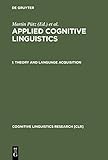Applied Cognitive Linguistics. I, Theory and Language Acquisition / ed. by Martin Pütz, Susanne Niemeier.
Material type: TextSeries: Cognitive Linguistics Research [CLR] ; 19.1Publisher: Berlin ; Boston : De Gruyter Mouton, [2012]Copyright date: ©2001Edition: Reprint 2012Description: 1 online resource (273 p.) : Zahlr. Abb. und TabellenContent type:
TextSeries: Cognitive Linguistics Research [CLR] ; 19.1Publisher: Berlin ; Boston : De Gruyter Mouton, [2012]Copyright date: ©2001Edition: Reprint 2012Description: 1 online resource (273 p.) : Zahlr. Abb. und TabellenContent type: - 9783110172218
- 9783110866247
- 415 23
- P165 .A66 2001eb
- online - DeGruyter
- Issued also in print.
| Item type | Current library | Call number | URL | Status | Notes | Barcode | |
|---|---|---|---|---|---|---|---|
 eBook
eBook
|
Biblioteca "Angelicum" Pont. Univ. S.Tommaso d'Aquino Nuvola online | online - DeGruyter (Browse shelf(Opens below)) | Online access | Not for loan (Accesso limitato) | Accesso per gli utenti autorizzati / Access for authorized users | (dgr)9783110866247 |
Frontmatter -- Acknowledgements -- List of Contributors -- Contents -- Contents of volume II -- Introduction -- Section 1: Cognitive approaches to the English tense system -- Cognitive linguistics, language pedagogy, and the English present tense -- Pretend play: trial ground for the simple present -- The relation between experience, conceptual structure and meaning: non-temporal uses of tense and language teaching -- Section 2: Facets of prototypes in grammatical constructions -- Grammatical constructions and their discourse origins: prototype or family resemblance? -- Transitivity parameter and prominence typology: a cross-linguistic study -- Section 3: Neurocognitive and cognitive issues of language acquisition in general -- Learning syntax - a neurocognitive approach -- Conceptual primes in early language development -- No preposition required. The role of prepositions for the understanding of spatial relations in language acquisition -- The ‘Graded Salience Hypothesis’ in second language acquisition -- Subject Index -- 275-276
restricted access online access with authorization star
http://purl.org/coar/access_right/c_16ec
As a usage-based language theory, cognitive linguistics is predestined to have an impact on applied research in such areas as language in society, ideology, language acquisition, language pedagogy. The present volumes are a first systematic attempt to carve out pathways from the links between language and cognition to the fields of language acquisition and language pedagogy and to deal with them in one coherent framework: applied cognitive linguistics.
Issued also in print.
Mode of access: Internet via World Wide Web.
In English.
Description based on online resource; title from PDF title page (publisher's Web site, viewed 28. Feb 2023)


